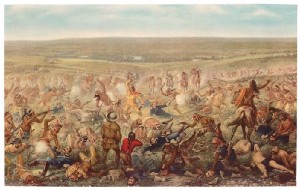The Ocoee Ranger page 2 June 2008
General Custer & His Troops Massacred In Dakota Territory
As World’s Fair Serves Ice Cream
June 25, 1876
That’s what the headlines in the papers said 132 years ago, or something about like that. While the world was celebrating all sorts of new inventions and technical marvels at the World’s Fair in Chicago, the Wild West was still happening. And the public was shocked, and outraged. The “boy general” of Civil War fame was killed in action on the plains by Indians. That thought was almost inconceivable.
Little Big Horn Battle Picture Made Famous By Anheueser-Bush In Saloons
After Custer’s defeat, lots of folks painted pictures of the “Last Stand”. The most famous was adopted by Anheueser-Bush and hung in saloons all across the country. The 1 thing that all the paintings had in common was a heroic last stand in which Custer bit the dirt. That was in the day when folks respected heroes, or at least the idea of heroes. Of course there was no “Last Stand”. Modern day archeology and battlefield explorations now show that there were a series of little battles in which soldiers were quickly over-run and killed.
When the smoke cleared, folks looked for explanations for the deaths of Custer and his troops. After all, George Custer had a big reputation for winning battles. He led from the front, and he took the battle to his foes. The defeat had to be someone’s fault, but not Custer’s. So, Major Marcus Reno came under investigation. Reno was to have circled the Indians, charged the main village, pulling fighters from the front, and then he was to have attacked the main force from the rear. And Custer was to have hit the main force from the front. But, Reno didn’t make it through the village. He made contact with more Indians than he expected and had to retreat to an adjacent hill, where his captains established a perimeter of defense, after the good Major went bonkers.
Freed from Reno’s attack, the warriors then reversed their direction of attack and struck Custer and his accompanying force. And in a matter of minutes, the battle was over, and Custer, his 2 brothers, his nephew, his brother-in-law and about 180 others were killed. Reno sought a court martial to consider the events and have a determination as to whether he was responsible for the defeat of the 7th Cavalry at Little Big Horn. After lots of hot air and testimony, Reno was determined to be not guilty. Sometime later, he was discharged for being a peeping tom, after looking into a young lady’s bedroom window.
Lt. Colonel “General” George A. Custer
And Custer, well, in defeat, he became immortal. But that’s not always been good. Depending upon the time when he’s been considered and the “politically correct” environment at the moment of consideration, he’s been hero and villain. Some authors and movie producers have made him to be a moronic buffoon. And his character helped when folks attempted to make him look un-heroic. George was vain: he looked like a peacock. And his on-going courtship of his wife was childish. And while he demanded discipline and was harsh in administering punishment for lack of such, he was not disciplined himself: he once went AWOL (absent without leave) to see Libby, his wife. And he was controversial. But one thing he was not: George Custer was no coward. He led from horseback at the front of his command.
Was George Custer incompetent as a battlefield commander, as his detractors have contended? Well, he became a General Officer as a battlefield commander. And after the Civil War, when the Army was reduced in size, as it has been following all of America’s wars, he was reduced in rank to Lieutenant Colonel, although still entitled to be addressed as General Custer. Most of his detractors have not been experienced battlefield commanders: they have been experienced opinion givers and debunkers.
Custer engaged an enemy force of superior numbers, when he could not believe there was so large a force. No other Indian engagement before or after Little Big Horn was fought by so many Indians. He divided his force to engage the enemy. In more modern battles in South East Asia, we called such action a cordon and search or hammer and anvil, closing the back door so folks wouldn’t slip away. Shucks, that’s what ol’ George did. His plan would have worked, if he hadn’t been fighting too many opponents, and opponents who were motivated to fight hard and kick butt. So, George lost the battle, and in doing so, he inspired the public, the politicians and the military to win the war. The Indians’ greatest victory was, in the long run, their greatest defeat. And Custer, nothing anyone writes convinces anyone of anything. People who feel he was a competent commander who made a mistake at 3:30 pm on June 25, 1876, will keep that thought. And people who feel he was an egotistical incompetent who finally got what he deserved, they will be forever convinced of their opinions. And the folks who feel pity for the noble Native Americans, they will retain their positions. Even though while politically correct in current terminology, there ain’t no Native Americans: their ancestors came from the “Old World”, just like all the rest of the population. And they took their territory from some other folks who were there before them, just like the European Americans. Custer’s war will never be really over. It’s just changed from an exchange of bullets to periodic exchanges of words. Of course as interest in the Old West wanes, most folks don’t really care.


 Entries (RSS)
Entries (RSS)